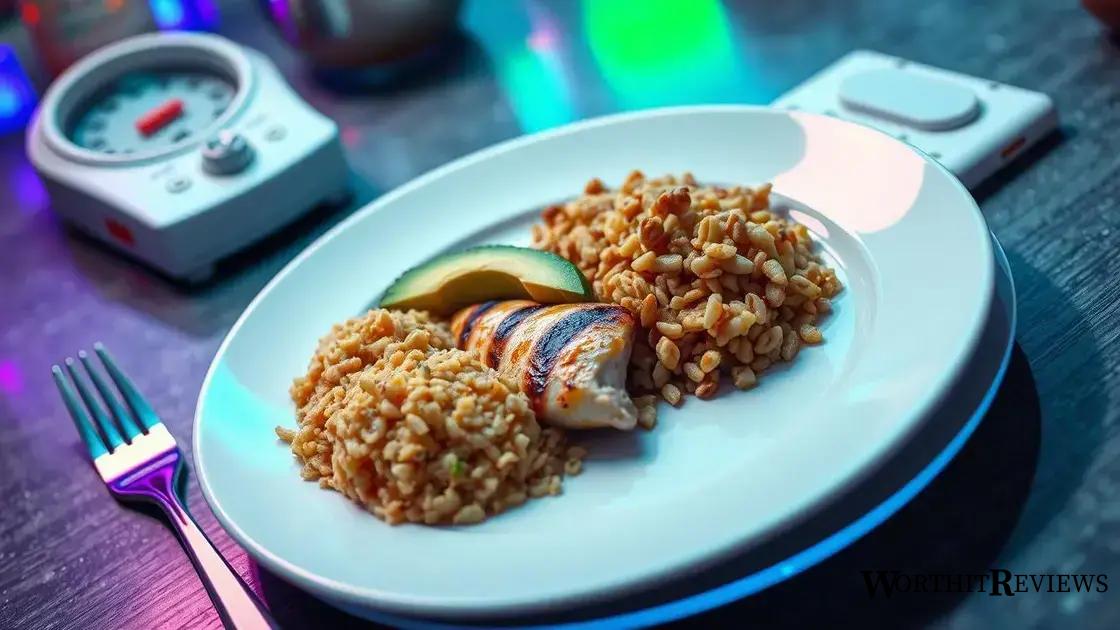Effective diet meal plans for weight loss prioritize balanced macronutrients, controlled calories, and personalized customization to achieve sustainable weight loss while accommodating individual dietary needs and preferences.
Diet meal plans for weight loss can make a significant difference in your health journey. Ever wondered how some people seem to breeze through their diets while you struggle? Let’s explore how to create effective and satisfying meal plans that actually work.
Understanding the importance of diet meal plans
Understanding the importance of diet meal plans is crucial for successful weight loss. A well-structured meal plan provides a roadmap for achieving your health goals, offering numerous benefits beyond just shedding pounds. It helps you control portions, ensuring you consume the right amount of calories and macronutrients. This prevents overeating, a common pitfall when trying to lose weight.
Benefits Beyond Weight Loss
Improved Nutrition: Diet meal plans encourage the consumption of nutrient-rich foods, including fruits, vegetables, and lean proteins. These foods provide essential vitamins and minerals that support overall health and well-being, boosting energy levels and improving bodily functions.
Reduced Cravings and Improved Energy Levels: By focusing on balanced meals and regular eating intervals, diet meal plans can help stabilize blood sugar levels. This leads to reduced cravings for unhealthy snacks and sustained energy throughout the day, making it easier to stick to your weight loss goals.
Better Eating Habits: A structured meal plan helps you develop healthier eating habits. It encourages mindful eating, prompting you to pay attention to what and how much you consume. This can lead to long-term changes in your dietary habits, even after you’ve achieved your target weight.
Time Management and Cost Savings: Planning your meals in advance saves time and reduces stress. It eliminates the daily guesswork of “what’s for dinner?” and allows for efficient grocery shopping, potentially leading to cost savings by reducing impulse purchases.
Key components of successful meal plans

Key components of successful meal plans include a balance of macronutrients, calorie control, and consideration of individual dietary needs and preferences. Let’s break down these elements:
Macronutrient Balance
Protein: Adequate protein intake is essential for building and repairing tissues, as well as keeping you feeling full and satisfied. Include lean protein sources like chicken, fish, beans, and lentils in your meal plan.
Carbohydrates: Choose complex carbohydrates over refined carbs. These provide sustained energy and fiber, which aids in digestion and helps regulate blood sugar levels. Opt for whole grains, fruits, and vegetables.
Healthy Fats: Don’t fear healthy fats! They are crucial for hormone production and nutrient absorption. Include sources like avocados, nuts, seeds, and olive oil in your diet.
Calorie Control
While macronutrient balance is vital, managing your calorie intake is key for weight loss. A successful meal plan will take into account your basal metabolic rate (BMR), activity level, and weight loss goals to determine the appropriate calorie range. Consult a nutritionist or use online tools to calculate your individual needs.
Individualization
No one-size-fits-all approach works for meal planning. Consider your dietary restrictions, allergies, and food preferences. A plan should be enjoyable and sustainable in the long run, making it easier to adhere to and achieve your weight loss goals. Think about what you like to eat and find ways to incorporate those foods into a healthy and balanced plan.
How to customize your meal plan for weight loss
Customizing your meal plan for weight loss ensures it aligns with your lifestyle, preferences, and dietary needs. Here’s how to personalize your plan:
Consider Your Dietary Needs and Preferences
Food Allergies and Intolerances: Eliminate any foods that trigger allergies or intolerances. Substitute with safe alternatives that offer similar nutritional value. For instance, if you’re lactose intolerant, opt for plant-based milk or lactose-free dairy products.
Food Preferences: Include foods you genuinely enjoy. A meal plan shouldn’t feel like a punishment. If you dislike certain healthy foods, find substitutes you find palatable. Experiment with different recipes and cuisines to keep your meals exciting.
Lifestyle and Schedule: Consider your daily routine and how much time you have for meal preparation. If you have a busy schedule, opt for quick and easy recipes or prepare meals in advance for the week.
Set Realistic Goals and Track Progress
Gradual Changes: Start with small, manageable changes. Don’t try to overhaul your entire diet overnight. Gradually introduce healthier food choices and adjust portion sizes.
Track Your Intake: Use a food journal or a mobile app to monitor your calorie intake and macronutrient ratios. This helps you stay accountable and identify areas for improvement. Tracking your progress also provides a sense of accomplishment and motivation.
Consult a Professional
Seek Guidance When Needed: If you have specific dietary requirements or underlying health conditions, consult a registered dietitian or nutritionist. They can create a personalized meal plan that addresses your individual needs and health goals. They can also provide guidance on portion control, nutrient timing, and other aspects of healthy eating.
Tips for sticking to your diet plan

Sticking to your diet plan can be challenging, but with the right strategies, you can maintain consistency and achieve your weight loss goals. Here are some practical tips:
Meal Prepping and Planning
Prepare Meals in Advance: Devote some time each week to preparing meals and snacks. This prevents impulsive unhealthy choices when you’re short on time or energy. Having ready-to-eat meals also makes it easier to track portions and stick to your calorie goals.
Plan Your Grocery List: Create a detailed grocery list based on your meal plan. This helps you avoid buying unnecessary or tempting foods that could derail your progress. Sticking to your list ensures you have the right ingredients on hand for healthy meals.
Mindful Eating and Support System
Practice Mindful Eating: Pay attention to your body’s hunger and fullness cues. Eat slowly and savor each bite. Avoid distractions like television or your phone while eating, as this can lead to overeating.
Build a Support System: Share your weight loss journey with friends, family, or a support group. Having people to encourage and motivate you can make a significant difference in your success. Consider joining online communities or finding a weight loss buddy for added support.
Celebrate Small Victories and Stay Flexible
Reward Yourself (Healthily): Celebrate milestones along the way to stay motivated. Reward yourself with non-food treats, like a new workout outfit or a relaxing activity.
Be Kind to Yourself: Don’t get discouraged by occasional slip-ups. Everyone deviates from their diet plan from time to time. Instead of dwelling on setbacks, acknowledge them, learn from them, and get back on track with your next meal.
Delicious recipes for weight loss meal plans
Delicious recipes are key to a sustainable weight loss meal plan. Healthy eating doesn’t have to be boring! Here are some ideas to get you started:
Breakfast
Overnight Oats: Combine rolled oats, chia seeds, your favorite milk (dairy or plant-based), and a touch of honey or maple syrup in a jar. Refrigerate overnight and top with fresh fruit and nuts in the morning for a quick and nutritious breakfast.
Greek Yogurt Parfait: Layer Greek yogurt with berries, granola, and a drizzle of honey for a protein-packed and satisfying breakfast.
Lunch
Quinoa Salad: Mix cooked quinoa with chopped vegetables like cucumbers, tomatoes, and bell peppers. Add grilled chicken or chickpeas for protein and toss with a light vinaigrette.
Lentil Soup: A hearty and filling soup packed with fiber and protein. Combine lentils, vegetables, and broth for a nutritious and satisfying lunch.
Dinner
Baked Salmon with Roasted Vegetables: Season salmon fillets with herbs and spices and bake until cooked through. Roast a variety of colorful vegetables like broccoli, carrots, and sweet potatoes alongside the salmon for a complete and balanced meal.
Chicken Stir-Fry: Stir-fry lean chicken breast with a mix of vegetables and a light sauce. Serve over brown rice or quinoa for a healthy and flavorful dinner.
Remember to adjust portion sizes based on your individual calorie needs and preferences. Explore different cuisines and experiment with new recipes to keep your meals exciting and prevent boredom. The internet is a treasure trove of healthy and delicious weight loss recipes, so get creative and enjoy the process!
Creating a Path to Success
Developing effective diet meal plans for weight loss is a journey of understanding your body, making informed choices, and embracing a sustainable approach to healthy eating. By focusing on macronutrient balance, calorie control, and personalized customization, you can create a meal plan that fuels your body, supports your weight loss goals, and fits seamlessly into your lifestyle. Remember that consistency is key, and celebrating small victories along the way can keep you motivated and inspired. Don’t be afraid to experiment with new recipes and find what works best for you. With a well-structured plan and a positive mindset, you can achieve lasting weight loss success and enjoy a healthier, happier you.
